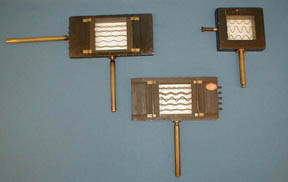Demos: 1S-45 Traveling & Standing Wave Forms

This classic Waggener wave apparatus demonstrates a variety of wave forms made visible on the overhead projector. The wave slide consists of five individual wire forms mounted so they can be moved independently by turning the projecting “knobs.” The wire forms demonstrate fully the two fundamental cases of interference: the stationary waves resulting from two wave systems of equal lengths, amplitudes, periods and wave velocities moving along the same row of particles in opposite directions; and the resultant of two systems of equal waves moving along the same row of particles in the same direction.
Directions: Place the apparatus on the overhead projector and focus the image. The descriptions of each function is a follows:
1. Equal waves moving in the same direction, separated by 1/2 wavelength, together with the resultant having zero amplitude (straight wire);
2. Same as (1), separated by 1/4 wavelength, with an amplitude equal to either component multiplied by the square root of 2;
3. Same as (1), but having zero phase difference. The resultant amplitude being double that of each component;
4. Two waves moving in opposite directions, with the resultant shown;
5. Two waves moving in opposite directions, with zero resultant.
Suggestions for Presentation: It would be helpful if you had an overhead transparency showing the various phase relationships, then turn the knobs so that students can see the time development.
Applications: Wave interference phenomena.
Last Updated: Nov 30, 2023 11:25 AM